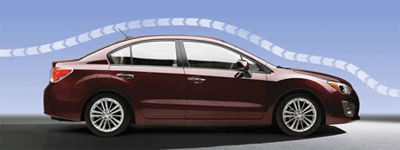It has to do with how vehicle components are made, what they’re made of, and how systems function.
While every aspect of a vehicle contributes in some way to its level of fuel economy, we’ll focus this discussion on how Subaru has improved fuel economy by addressing these areas:
Vehicle aerodynamics – how a vehicle moves through the air
Reduced weight – a lighter vehicle tends to achieve better fuel economy
– Body
– Drivetrain components and systems
Component and system design – engineering for light weight, smooth operation, and aerodynamic efficiency
Efficient functionality – operating with low losses of energy to friction
– Engine
– Transmission
– Drivetrain
 Aerodynamic Shapes
Aerodynamic Shapes
How a vehicle moves through the air helps determine the amount of fuel that must be used by the engine to overcome drag – friction caused by the air. A measure used by manufacturers that indicates the aerodynamic efficiency of a vehicle’s body is called “coefficient of drag,” or Cd. Multiplying that figure by the frontal area of the vehicle gives a numeric indicator of its aerodynamic drag.
A vehicle’s overall shape, the finish of its surfaces, and how air flows through cooling and ventilating systems all affect its Cd, which can be measured in wind-tunnel tests. The lower a vehicle’s Cd, the better it moves through the air, and the better its fuel economy.
read more....